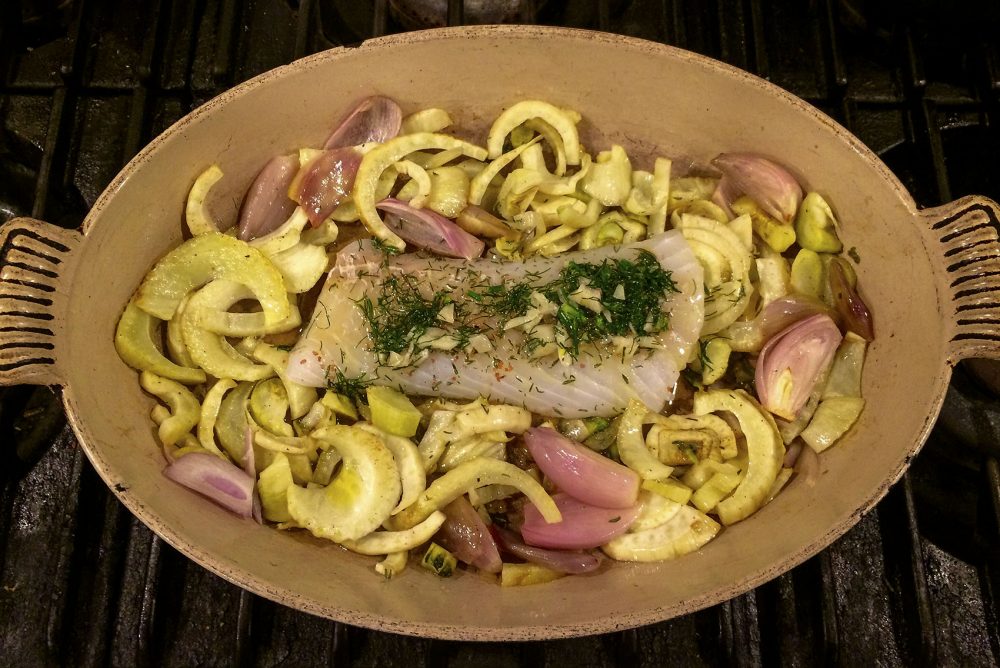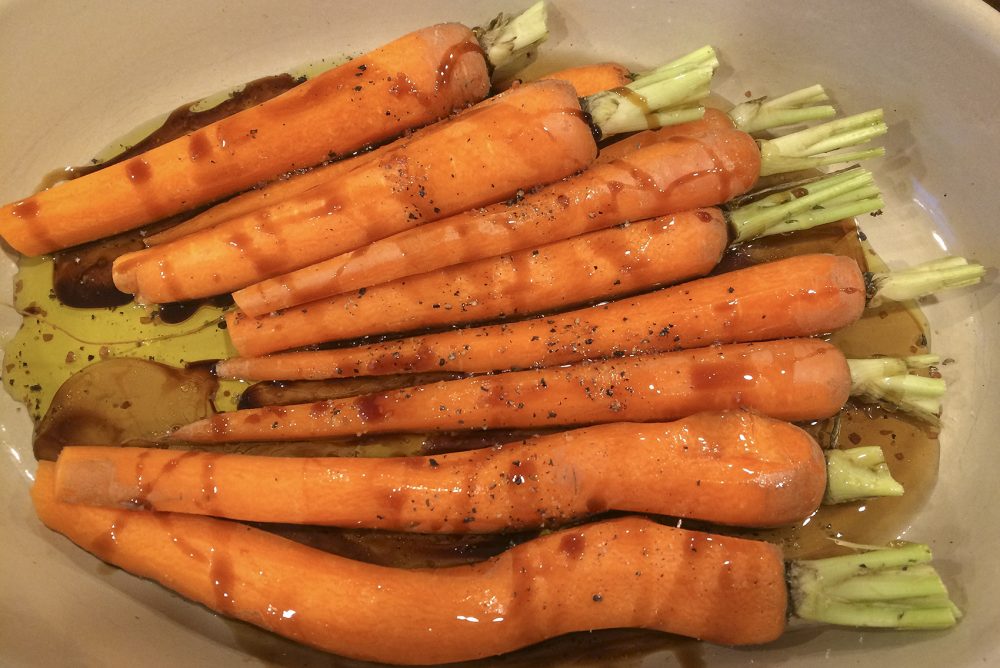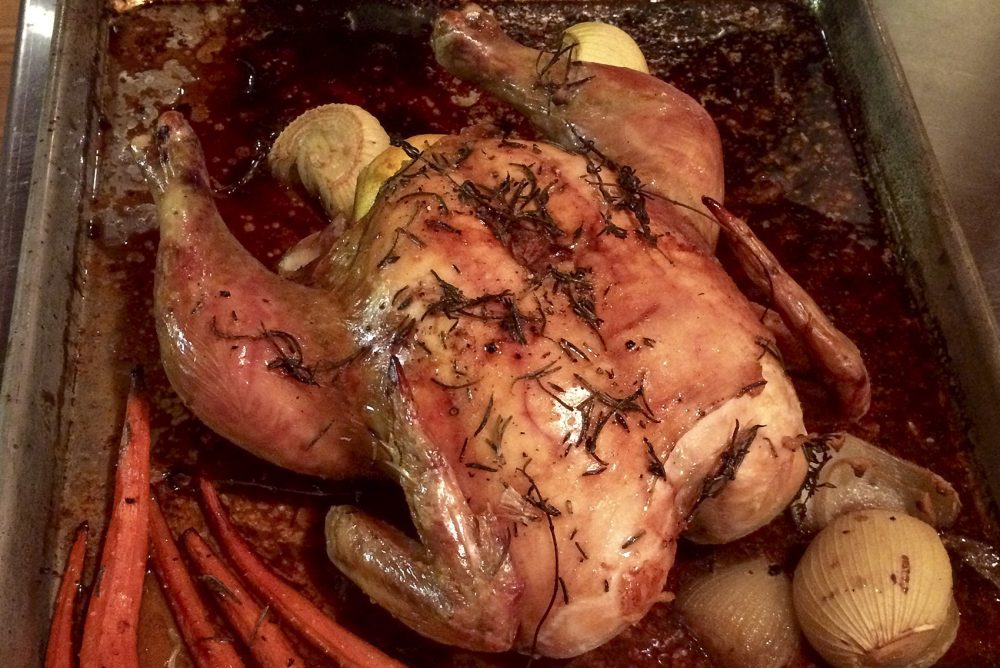Advertisement
From Chicken To Fish, Tips For The Do's And Don'ts Of Roasting
Resume
Just in time for the holidays, Here & Now resident chef Kathy Gunst gives host Jeremy Hobson tips on roasting meats and vegetables. Kathy also provides recipes for a standing rib roast as well as roasted cod, chicken and carrot dishes.
Roasted Cod On A Bed Of Roasted Fennel And Shallots
You can make this simple roasted dish using any type of firm, white fish. The fennel and shallots can be roasted several hours ahead of time, and the dish can be finished off in under 20 minutes.
Ingredients
- 2 bulbs fennel, cored and thinly sliced (reserve the fennel fronds)
- 4 shallots, peeled and quartered
- 1 tablespoon olive oil
- Salt and freshly ground black pepper
- 1 1/2 tablespoons butter
- 1 clove finely chopped garlic
- 2 tablespoons fennel fronds (from the chopped fennel)
- 1 tablespoon lemon juice
- 1 pound cod or firm white fish
- About 1/4 cup panko or regular breadcrumbs
Instructions
- Preheat the oven to 425 degrees.
- In a shallow roasting dish or gratin pan, mix the fennel, shallots and olive oil. Season with salt and pepper. Roast on the middle shelf for 12 minutes, or until the vegetables just begin to soften and brown. Remove from the oven and let cool slightly or cover and refrigerate for the several hours or until ready to roast.
- Meanwhile, in a small pot or skillet, heat the butter over moderate heat. Add the garlic, fennel fronds, pepper and simmer for 2 minutes. Add the lemon juice and remove from the heat.
- Reduce the oven temperature to 375 degrees. Push the fennel and shallots to the sides of the roasting dish and place the cod in the center. Season with salt and pepper. Spoon the garlic butter on top. Roast for 10 minutes. Spoon the panko breadcrumbs on top of the cod and place under the broiler for about 5 minutes, or until the top of the fish is golden brown and it appears to be cooked through and flakes easily on the side when tested with a fork or small sharp knife.
- Remove and serve with lemon wedges. Serves 2 to 3.
Standing Rib Roast
From "Roasting," by Kathy Gunst
The recipe for a holiday standing rib roast is as simple and straightforward as can be: stud the beef with garlic, sprinkle with pepper, and surround with potatoes and onions and stick it in the oven.
What makes the difference between a perfectly cooked, juicy roast and a dry, unappealing one? Start with the best cut of beef you can afford: hopefully a locally and sustainably raised prime cut. Figure on 3/4 pound per person, with leftovers.
Serve with horseradish or whipped cream flavored with horseradish.
Beef Ingredients
- One well-aged, 5-pound standing rib roast, about 3 ribs, trimmed of excess fat and tied
- 3 cloves garlic, peeled and thinly sliced
- Freshly ground black pepper
- Sweet Hungarian paprika
The Accompaniments
- 20 small new potatoes, peeled or not, cut in half or left whole if small
- 20 small white boiling onions or Cipollini onions, peeled and left whole
- Salt and freshly ground black pepper
- 1 tablespoons chopped fresh thyme
Instructions
- Preheat the oven to 450 degrees.
- Using a small, sharp knife, make several slits in the fat along the top of the beef and gently insert the garlic slices. Season the top of the beef liberally with pepper and paprika. Place the beef in a large roasting pan. Surround the beef with the potatoes and onions and season the vegetables with salt, pepper, and thyme.
- Roast the beef for 15 minutes. Reduce the heat to 325 degrees. Continue roasting until the internal temperature (tested with a meat thermometer) reaches 125 degrees for rare meat, about 18 minutes per pound, or 20 minutes per pound for medium, about 1 hour and 15 minutes total roasting time. Baste the beef and vegetables several times and turn the vegetables over so they brown evenly, being careful not to leave the oven door open for too long.
- Remove the roasting pan from the oven and let the beef sit in the pan. If you’re worried about the meat getting too cool, very very loosely covered with foil, about 15 minutes before carving.
- Transfer beef to a carving board and the vegetables to a warm bowl. Remove any excess fat from the pan. You can either serve the bone with the meat still on it or cut the meat off the bone. Serve the beef with pan juices poured on top. Pass the vegetables separately. Serves 6.

Roasted Carrots With Pomegranate Molasses And Maple Syrup Glaze And Pomegranate Seeds
This is such a beautiful dish — bright-orange carrots in a sweet, maroon glaze topped with pomegranate seeds. It’s simple, healthy, great winter cooking, and an ideal side dish to any holiday roast. The recipe can easily be doubled for a crowd.
Ingredients
- 8 small to medium carrots, peeled with root end still attached (if large, cut in half lengthwise)
- 1 tablespoon olive oil
- Sea salt and freshly ground black pepper
- 2 1/2 tablespoons pomegranate molasses (available in Middle Eastern shops and grocery stores)
- 2 tablespoons maple syrup or honey
- 1/4 cup pomegranate seeds, removed from 1 large pomegranate
Instructions
- Preheat the oven to 450 degrees.
- Place carrots in a shallow roasting pan or ovenproof skillet. Drizzle on the olive oil, salt, pepper, pomegranate molasses and toss well. Roast on the middle shelf for about 12 minutes. Pour on the maple syrup and roast another 10 to 15 minutes or until the carrots are almost soft (they will continue to cook when you remove them from the oven), tossing them once or twice.
- Serve hot or at room temperature, scattered with the pomegranate seeds. Serves 4.

Roast Chicken With Lemon And Roasted Garlic-Herb Butter
Roast chicken is satisfying any time of year, but there is something particularly wonderful about this dish on a cold winter's night. What makes this recipe unique is the lemon inside the cavity and roasted garlic-herb butter that is tucked under the skin of the breast meat, and then "massaged" on the outside of the bird, creating crisp skin and flavorful, moist meat.
You can surround the bird in the roasting pan with potatoes, parsnips, onions, leeks or any other vegetables. Serves 4.
Garlic-Herb Butter Ingredients
- 5 large garlic cloves, peeled
- 1 tablespoon olive oil
- 3 tablespoon butter, at room temperature
- Pinch of salt, or to taste
- A few grindings black pepper
- 1 tablespoon fresh chopped sage, or 1 teaspoon dried and crumbled
- 1 tablespoon chopped fresh rosemary, or 1 teaspoon dried and crumbled
- 1/2 tablespoon chopped fresh thyme, or ¼ teaspoon dried crumbled
Chicken And Vegetables Ingredients
- One 3- to 4-pound roasting chicken, preferably organic or naturally raised
- 1 lemon, washed and dried with a small “X” cut in the middle
- 1/2 pound young parsnips (not enormous or fat, about 4), peeled and cut into pieces about 2 inches long and ½ inch wide
- 1/2 pound carrots (about 2 to 3 large), peeled and cut into pieces about 2 inches long and 1/2 inch wide
- 4 medium onions, peeled and cut into quarters
- 1 1/2 pounds Fingerling or new potatoes (cut in half if large)
- 1/8 teaspoon sea salt
- Generous grinding black pepper
- 1 1/2 to 2 tablespoons olive oil
- 1 1/2 cups dry red or white wine
Instructions
- To make the garlic-herb butter, preheat the oven to 350 degrees. Place the garlic in a small roasting pan or ovenproof skillet and pour the tablespoon of oil on top. Roast on the middle rack for 15 minutes, tossing the garlic once or twice. (If the garlic cloves are small they will be tender and ready after about 11 minutes.) Remove from the oven and let the garlic cool about 5 minutes.
- In a small bowl, mash the butter with the back of a spoon. Add the salt, pepper, sage, rosemary, and thyme and mix well. Finely chop the roasted garlic (it will become a paste, which is fine) and add it to the butter. Mix in the oil from the roasting pan. (The butter can be made 24 hours ahead of time.)
- Preheat the oven to 450 degrees. Rinse the chicken and cut off any excess fat near the flaps of the cavity. Place the lemon in the cavity. By wiggling your fingers under the skin, gently loosen the breast skin from the breast meat to create a small pocket. Distribute half of the garlic-herb butter under both sides of the breast skin, massaging it into the breast meat. Rub the remaining butter over the outside of the bird, massaging it onto the skin of the breast, wings, and drumsticks. Place the bird in the middle of a large roasting pan. Surround the chicken with the vegetables and potatoes and season with salt and pepper. Drizzle the 1 ½ to 2 tablespoons of oil over the vegetables and potatoes (enough to give them a very light coating) and toss them with a spoon or by shaking the pan to distribute evenly on the vegetables.
- Roast the chicken on the middle rack for 25 minutes. Pour half the wine over the bird, and reduce the temperature to 375 degrees. Gently toss the potatoes and vegetables. Roast for another 20 minutes, and pour the remaining wine on top of the bird. Gently toss the vegetables again so they brown and cook evenly. Roast for another 20 to 25 minutes, or until the drumstick feels loose when you gently wiggle it, or the juices run clear and not pink when you pierce the meat under the wing or the thickest part of the thigh. Remove from the oven and let cool for 5 minutes before carving. Remove and discard the lemon and serve the meat with the potatoes and vegetables on the side and spoon any pan juices on top of the chicken.
8 Tips For Successful Roasting
- Always preheat the oven and place the shelf in the middle unless otherwise indicated.
- Never crowd a roasting pan. You want ample room around the sides of whatever you are roasting, otherwise the food will begin to steam.
- Choose a roasting pan with low sides; you don't want high sides or again the food will not be roasted all the way through but might steam on the bottom.
- In a world of low fat cooking many cooks are tempted to remove all the fat from a roast before cooking. A layer of fat acts as a natural baster and causes a roast to obtain its golden brown color. Always roast with the fat side up — you can always de-grease a roast after it’s done.
- When tenting a roast be sure it’s very, very loose or you will steam your food. Only tent to keep something warm for a few minutes.
- Don't add too much liquid to the pan when roasting.
- Remember that roasted food continues to cook even after you’ve removed the pan from the oven. Always remove roasted food just before you think it’s done and it will finish cooking when you take it out. You can always put food back in the oven, but once it’s overcooked, it’s always overcooked.
- Roasting works well with vegetables, fish, poultry, meat and fruit. Experiment!
This article was originally published on December 22, 2016.
This segment aired on December 23, 2016.
